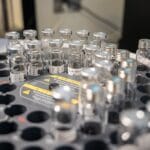By Emily Ayshford
When Avi Gargye visited his family in India as a child, he was surprised by the routine blackouts caused by the strain on the country’s electrical grid.
“I started to notice the large impact energy has on our quality of life, and I wanted to find ways to make it more accessible and reliable,” he said.
As a high school student, he conducted research on biohybrid solar cells made out of spinach and blackberries at Vanderbilt University—an experience that “made me interested in chemical engineering and how it could help me solve those problems I saw as a kid,” he said.
He went on to get a BS in chemical engineering from Vanderbilt, then spent two years in industry—one with the Army Corps of Engineers, and one at electric vehicle manufacturer Rivian—before deciding to embark on his PhD.
The University of Chicago Pritzker School of Molecular Engineering (UChicago PME) seemed like a natural fit. He liked the interdisciplinary nature of the school, as well as its solutions-oriented approach. Perhaps best of all, he liked the school’s partnership with Argonne National Laboratory, with its world-renowned battery research program.

“Batteries are the bottleneck in the renewable energy transition,” he said. “You can produce all the solar and wind energy you want, but if you don’t have anywhere to store it, that limits our ability to use that energy. I thought it was an area where I could really make an impact.”
Now, Gargye conducts research at Argonne under his research adviser Daniel Abraham, a senior materials scientist at the lab, into how batteries degrade—and potential strategies to mitigate that degradation. “Batteries are made of many different materials that are constantly interacting with each other. That makes battery failure complex but also fascinating,” he said.
He studies sodium-ion batteries, which are considered a sustainable alternative to the more-popular lithium-ion batteries but which can’t hold as much energy.
Gargye is trying to figure out how to increase the batteries’ energy density while mitigating their degradation. He uses electrochemical techniques to measure the degradation of materials inside the batteries.
“Argonne has this huge cluster of scientists and experts that I can tap into,” he said. “It really makes conducting research a lot easier when I have so many resources for when I run into a problem.”
“Avi brings both curiosity and ingenuity to his work, developing fresh approaches that have deepened our understanding of lithium and sodium batteries,” said Abraham.
“Immersed in a community of world-class battery scientists at the national lab, he’s gaining mentorship and training few PhD students receive. This experience will position him strongly for the next stage of his career,” said his academic advisor, Associate Professor Shrayesh Patel.

At UChicago PME, Gargye started a student chapter of the Electrochemical Society, which brings in speakers and networking opportunities for students. He also participates in the UChicago PME Science Communications Program, and recently did a Junior Science Café on those blackberry solar cells he studied back in high school.
“That was the research that convinced me to become an engineer, so using that example for elementary and middle school students was a full-circle moment,” he said.
After graduation, Gargye hopes to go back into industry to ensure that his research can have an impact on the market. “I took a couple of years after college to work in these different research environments and learn how research ideas move from the lab to the real world,” he said. “I want to go back to industry and be a bridge between those making advances in fundamental science and those actually deploying the technology.”
























